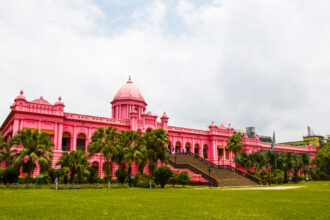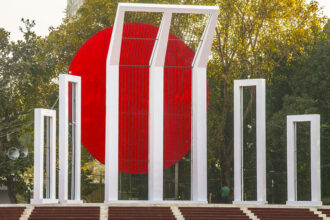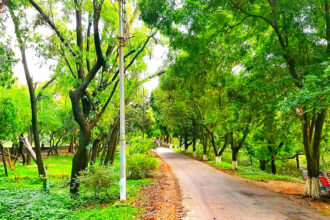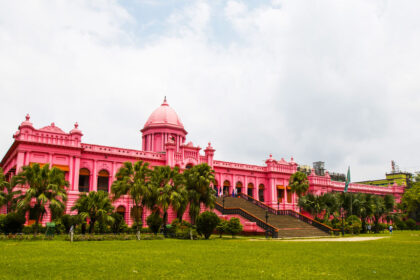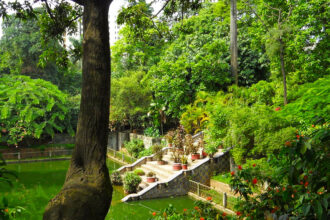The Hornbill Festival of Nagaland is an annual cultural event held in December. It celebrates the rich heritage of the Naga tribes.
The Hornbill Festival, often called the “Festival of Festivals,” takes place in Kisama village near Kohima, Nagaland. This vibrant event showcases the diverse traditions, dances, and crafts of the Naga tribes. Visitors can experience traditional Naga music, authentic cuisine, and indigenous games.
The festival aims to promote and preserve Naga culture while fostering unity among the tribes. Tourists from around the world flock to witness this unique celebration. Held from December 1st to 10th, the festival offers a deep dive into the cultural richness of Nagaland. The Hornbill Festival is a must-visit for anyone interested in indigenous cultures and traditions.
Origins Of The Festival
The Hornbill Festival of Nagaland is a grand celebration that showcases the rich cultural heritage of the Naga tribes. Known as the “Festival of Festivals,” this event brings together various tribes from across the state. It offers a vibrant display of traditional music, dance, and crafts. But how did this colorful festival come into existence? Let’s delve into the origins of the festival to understand its significance and history.
Early Beginnings
The Hornbill Festival was first celebrated in the year 2000. The government of Nagaland initiated it to promote the cultural heritage of the state. This festival was named after the hornbill bird, which is a significant symbol in Naga culture. The idea was to create a platform for all tribes to showcase their traditions and foster unity among them.
Symbolism Of The Hornbill Bird
The hornbill bird holds a special place in Naga folklore and traditions. It symbolizes respect, courage, and valor. The bird’s feathers are often used in traditional Naga headgears. This makes the hornbill an apt symbol for a festival that celebrates the essence of Naga culture.
Government’s Role
The government played a crucial role in the inception of the Hornbill Festival. They aimed to preserve and revive Naga traditions, which were at risk of fading away. By creating this festival, they provided a platform for tribes to share their unique practices. This initiative has significantly boosted tourism in Nagaland.
Community Involvement
The involvement of the local community is vital to the festival’s success. Each tribe participates with enthusiasm, showcasing their unique dances, music, and crafts. This participation not only preserves their heritage but also educates the younger generation about their roots. The community’s active role ensures the festival’s vibrancy and authenticity.
Evolution Over The Years
Since its inception, the Hornbill Festival has grown in scale and popularity. Initially, it was a modest event with limited participation. Today, it attracts visitors from all over the world. The festival has expanded to include modern elements like rock music concerts and fashion shows. Despite these additions, the core focus remains on celebrating Naga culture.
The Naga Tribes
The Hornbill Festival in Nagaland is a vibrant celebration of the rich cultural heritage of the Naga tribes. This festival, held every December, showcases the traditions, dances, and crafts of the Naga people. Understanding the Naga tribes enriches the experience of this grand festival.
The Angami Tribe
The Angami tribe is known for their intricate wooden carvings and warrior traditions. They celebrate Sekrenyi, a festival of purification and renewal.
The Ao Tribe
The Ao tribe is famous for their folklore and colorful festivals. Moatsu is their main festival, marking the end of the sowing season.
The Konyak Tribe
The Konyak tribe is recognized for their headhunting history and tattooed faces. Their festival, Aoleang, celebrates the arrival of spring and the new year.
The Lotha Tribe
The Lotha tribe is known for their rich oral history and traditional attires. Tokhu Emong is their harvest festival, celebrated with dance and feasting.
The Chakhesang Tribe
The Chakhesang tribe is distinguished by their weaving skills and unique customs. They celebrate Sükrünye, a festival of sanctification and community bonding.
The Sumi Tribe
The Sumi tribe is known for their vibrant dances and warrior legacy. Tuluni is their major festival, celebrating the bountiful harvest.
The Pochury Tribe
The Pochury tribe is noted for their traditional music and craftsmanship. Yemshe is their festival, marking the end of the agricultural year.
The Rengma Tribe
The Rengma tribe is famous for their folk songs and dances. Ngada is their post-harvest festival, celebrated with great enthusiasm.
The Zeliang Tribe
The Zeliang tribe is known for their artistic skills and rich cultural heritage. Hega is their festival, celebrating fertility and prosperity.
| Tribe | Main Festival | Key Features |
| Angami | Sekrenyi | Wooden carvings, warrior traditions |
| Ao | Moatsu | Folklore, colorful festivals |
| Konyak | Aoleang | Headhunting history, tattooed faces |
| Lotha | Tokhu Emong | Oral history, traditional attires |
| Chakhesang | Sükrünye | Weaving skills, unique customs |
| Sumi | Tuluni | Vibrant dances, warrior legacy |
| Pochury | Yemshe | Traditional music, craftsmanship |
| Rengma | Ngada | Folk songs, dances |
| Zeliang | Hega | Artistic skills, cultural heritage |
Festive Highlights
The Hornbill Festival of Nagaland is a vibrant celebration that brings together the rich cultural heritage of the Naga tribes. Known as the ‘Festival of Festivals,’ it is a unique and colorful event that showcases the customs, traditions, and art forms of Nagaland. The festival is held every December in the Kisama Heritage Village. This section will highlight the key festive activities and experiences.
Traditional Dance Performances
One of the most captivating highlights is the traditional dance performances. Each Naga tribe has its unique dance form, often performed in elaborate costumes. The synchronized movements and rhythmic beats are mesmerizing. These performances offer a glimpse into the cultural richness of the region.
Indigenous Music And Instruments
The festival features indigenous music played with traditional instruments like the log drum and bamboo flute. Each performance tells a story, reflecting the tribe’s history and traditions. The melodies are both haunting and beautiful, adding a magical touch to the festivities.
Naga Morungs Exhibition
The Naga Morungs, or traditional community halls, are an essential part of the festival. Each tribe sets up a Morung to display their unique artifacts, crafts, and lifestyle. Visitors can explore these exhibitions to understand better the diverse cultures of Nagaland.
Food Fiesta
The Hornbill Festival is a paradise for food lovers. The food stalls offer a variety of traditional Naga dishes, including smoked pork, bamboo shoot curry, and spicy chutneys. The flavors are unique and provide an authentic taste of Naga cuisine.
Handicrafts And Artisans
The festival is also a hub for artisans showcasing their crafts. Visitors can purchase handmade items like bamboo products, woven textiles, and intricate beadwork. These crafts are perfect souvenirs and support the local artisans.
Adventure Activities
For thrill-seekers, the festival offers various adventure activities like rock climbing, trekking, and archery. These activities add an exciting element to the cultural festivities, allowing visitors to experience the natural beauty of Nagaland.
Fashion Show
The Naga Fashion Show is a glamorous event where local designers showcase their creations. The designs often blend traditional motifs with modern styles. This event highlights the evolving fashion scene in Nagaland.
Night Carnival
The night carnival is a lively affair with music, dance, and food. The carnival atmosphere is electric, providing a perfect end to the day’s festivities. The streets come alive with lights, laughter, and the vibrant spirit of the Hornbill Festival.
Planning Hornbill Festival Experience
The Hornbill Festival, held in Nagaland, India, is a vibrant cultural event that attracts visitors from around the world. Known as the “Festival of Festivals,” it showcases the rich heritage of the Naga tribes. Planning your Hornbill Festival experience can be an exciting journey. Here’s a detailed guide to help you prepare for this unforgettable event.
Travel Arrangements
Ensure you book your flights and accommodations well in advance. The nearest airport is in Dimapur. From Dimapur, you can take a taxi to Kohima, the festival’s main venue. For a more scenic route, take a train to Dimapur. Local transport includes buses, taxis, and rental cars.
Accommodation Options
Accommodation ranges from luxury hotels to budget stays. For a comfortable stay, consider booking hotels in Kohima. Alternatively, stay in homestays or guesthouses for a more authentic experience. Here’s a quick table for reference:
| Type | Price Range (per night) | Location |
| Luxury Hotels | $100 – $200 | Kohima |
| Mid-Range Hotels | $50 – $100 | Kohima |
| Budget Stays | $20 – $50 | Nearby Villages |
| Homestays | $10 – $30 | Local Villages |
Packing Essentials
Pack according to the weather and terrain. December in Nagaland is chilly, so bring warm clothes. Essentials include comfortable shoes, a raincoat, and a first-aid kit. Don’t forget your camera to capture the festival’s vibrant moments.
Festival Highlights
The festival features traditional dances, music, and food. Attend the night bazaar for local handicrafts. Witness the Hornbill Rock Contest, a must-see event. Participate in indigenous games and sample authentic Naga cuisine.
Cultural Etiquette
Respect local customs and traditions. Always ask permission before photographing locals. Dress modestly to honor the cultural norms. Engage with the community to enrich your festival experience.
Safety Tips
Stay aware of your surroundings and keep your belongings secure. Carry a copy of your ID and keep emergency contacts handy. Follow local guidelines to ensure a safe and enjoyable visit.
Hornbill Festival Essentials
The Hornbill Festival of Nagaland is an annual cultural extravaganza held in December, celebrating the rich heritage and traditions of the Naga tribes. Known as the ‘Festival of Festivals,’ it draws visitors from around the globe. To enjoy the festival to the fullest, it’s essential to be well-prepared. Here are some Hornbill Festival essentials to consider:
Comfortable Walking Shoes
Exploring the Hornbill Festival requires a lot of walking. The festival grounds are vast, with various events, stalls, and performances spread across different areas. Wearing comfortable walking shoes is a must to keep your feet happy and pain-free throughout the day.
Here are some tips for selecting the right shoes:
- Supportive soles: Choose shoes with good arch support to prevent foot fatigue.
- Breathable material: Opt for shoes made of breathable fabric to keep your feet cool.
- Water-resistant: Consider water-resistant shoes in case of unexpected rain.
- Well-fitted: Ensure the shoes fit well to avoid blisters.
Avoid high heels or flip-flops as they can cause discomfort and slow you down. Instead, go for sturdy sneakers, hiking boots, or comfortable walking sandals. Remember, happy feet mean a happy festival experience!
Weather-appropriate Clothing (consider Potential Rain And Cooler Evenings)
Nagaland’s weather in December can be unpredictable. Days are usually pleasant, but evenings can get chilly, and there is always a chance of rain. Packing weather-appropriate clothing is crucial to stay comfortable throughout the festival.
Consider the following clothing items:
- Layered clothing: Wear layers that can be easily added or removed as the temperature changes.
- Light jacket or sweater: Keep a light jacket or sweater handy for cooler evenings.
- Raincoat or poncho: Carry a raincoat or poncho to stay dry during sudden showers.
- Comfortable pants: Choose comfortable pants that allow easy movement.
A table summarizing the essentials:
| Item | Purpose |
| Layered clothing | Adapt to changing temperatures |
| Light jacket/sweater | Stay warm in the evening |
| Raincoat/poncho | Protection from rain |
| Comfortable pants | Ease of movement |
By packing appropriately, you will be prepared for any weather condition, ensuring you can enjoy the Hornbill Festival without any discomfort.
Community Engagement
The Hornbill Festival of Nagaland offers a unique opportunity to engage with the vibrant cultures and traditions of the Naga tribes. Known as the “Festival of Festivals,” it showcases an array of cultural performances, crafts, food, and more. One of the most enriching aspects of the festival is community engagement, where visitors can interact with local tribes, participate in workshops, and immerse themselves in the cultural exchange.
Interaction With Naga Tribes
Engaging with the Naga tribes is a highlight of the Hornbill Festival. The Naga people are known for their hospitality and eagerness to share their rich cultural heritage. Visitors can participate in various activities to better understand the tribal way of life.
- Traditional Dance and Music: Witness and even join in traditional dance performances that tell stories of bravery and folklore.
- Local Cuisine: Taste traditional Naga dishes prepared by the tribes themselves, offering an authentic culinary experience.
- Handicrafts: Learn about the intricate art of Naga handicrafts, including weaving, pottery, and bamboo work.
These interactions provide a deeper understanding of the Naga culture and foster a sense of community and mutual respect.
Workshops And Cultural Exchange Programs
The Hornbill Festival features various workshops and cultural exchange programs aimed at promoting understanding and appreciation of the Naga culture. These workshops cover a wide range of topics and are open to all visitors.
| Workshop | Description |
| Traditional Weaving | Learn the ancient art of weaving from skilled Naga artisans. |
| Cooking Classes | Participate in cooking classes to learn how to prepare traditional Naga dishes. |
| Storytelling Sessions | Listen to folk tales and legends narrated by tribal elders. |
These programs not only educate but also provide a platform for meaningful cultural exchanges, enriching the festival experience.
Reusable Water Bottle
Staying hydrated during the festival is crucial, and carrying a reusable water bottle is highly recommended. Not only is it environmentally friendly, but it also ensures you have access to water throughout the day.
- Eco-friendly: Reduce plastic waste by using a reusable water bottle.
- Convenient: Easily refill at water stations available at the festival venue.
- Health: Stay hydrated to keep your energy levels high and enjoy the festival activities.
Remember to choose a durable and easy-to-carry bottle to keep you hydrated throughout your visit.
Hat And Sunglasses
The Hornbill Festival takes place outdoors, and protecting yourself from the sun is important. A hat and sunglasses are essential items to carry.
- Sun Protection: A wide-brimmed hat provides ample shade and protects your face from harmful UV rays.
- Comfort: Sunglasses reduce glare and help you enjoy the performances and activities without straining your eyes.
- Style: Choose accessories that complement your outfit and add to the festival vibe.
These simple items can make your festival experience more comfortable and enjoyable.
Camera With Extra Batteries And Memory Cards
Capturing the vibrant moments of the Hornbill Festival is a must. Bring a camera with extra batteries and memory cards to ensure you don’t miss any special moments.
- High-Quality Photos: A good camera captures the essence of the festival in high resolution.
- Backup: Extra batteries and memory cards ensure you can take pictures all day long.
- Memories: Preserve the memories of your cultural immersion for years to come.
Having the right equipment ensures you can document your experience without any interruptions.
Local Currency (cash Is Preferred By Many Vendors)
Many vendors at the Hornbill Festival prefer cash transactions. Carrying local currency is advisable to enjoy a hassle-free shopping and dining experience.
- Ease of Transactions: Cash is widely accepted and speeds up transactions.
- Support Local Economy: Purchasing directly from vendors supports the local economy.
- Convenience: Avoid the need to find ATMs or deal with card issues.
Ensure you have enough local currency to fully enjoy all the festival has to offer.
Small Backpack Or Bag For Carrying Essentials
Carrying a small backpack or bag is essential for keeping your belongings safe and organized. It allows you to carry all your necessities without any hassle.
- Comfort: Choose a comfortable and lightweight bag to carry around all day.
- Organization: Keep your essentials like water bottle, hat, camera, and money organized.
- Security: A small bag helps keep your belongings secure and within reach.
A well-organized bag ensures you have everything you need at your fingertips.
Adapters Or Converters For Electronic Devices (if Needed)
If you are traveling from outside India, you may need adapters or converters for your electronic devices. Ensure you have the right equipment to keep your devices charged and ready.
- Compatibility: Different countries have different plug types; ensure your devices are compatible.
- Convenience: Keep your phone, camera, and other devices charged throughout the festival.
- Preparedness: Avoid the hassle of finding adapters locally by bringing your own.
Having the right adapters ensures you can use all your electronic devices without any interruptions.
Enthusiasm And An Open Mind To Embrace The Cultural Experience!
The most important thing to bring to the Hornbill Festival is your enthusiasm and an open mind. Embrace the cultural experience and enjoy every moment.
- Positive Attitude: Approach the festival with excitement and curiosity.
- Respect: Show respect for the local customs and traditions.
- Engagement: Participate in activities and interact with the locals to enrich your experience.
Your enthusiasm and openness will make your visit to the Hornbill Festival a memorable and enriching experience.
Frequently Asked Questions
The Hornbill Festival celebrates Naga culture with traditional music, dance, and food. It features craft exhibitions, indigenous games, and vibrant tribal performances. Held annually in December in Nagaland, India, it promotes unity and cultural heritage. The festival attracts tourists worldwide, offering a unique cultural experience.
The best day to visit the Hornbill Festival is on December 1st. This day marks the festival’s grand opening.
The Hornbill Festival features traditional dances, folk songs, tribal ceremonies, indigenous crafts, local cuisine, and sports competitions. It also includes vibrant markets, art exhibitions, and cultural performances.
Conclusion
The Hornbill Festival of Nagaland offers a vibrant cultural experience. It’s a must-visit for history and tradition enthusiasts. This festival brings together diverse Naga tribes. Enjoy traditional music, dance, and cuisine. The Hornbill Festival truly showcases Nagaland’s rich heritage. Plan your visit and immerse yourself in this unforgettable celebration.


